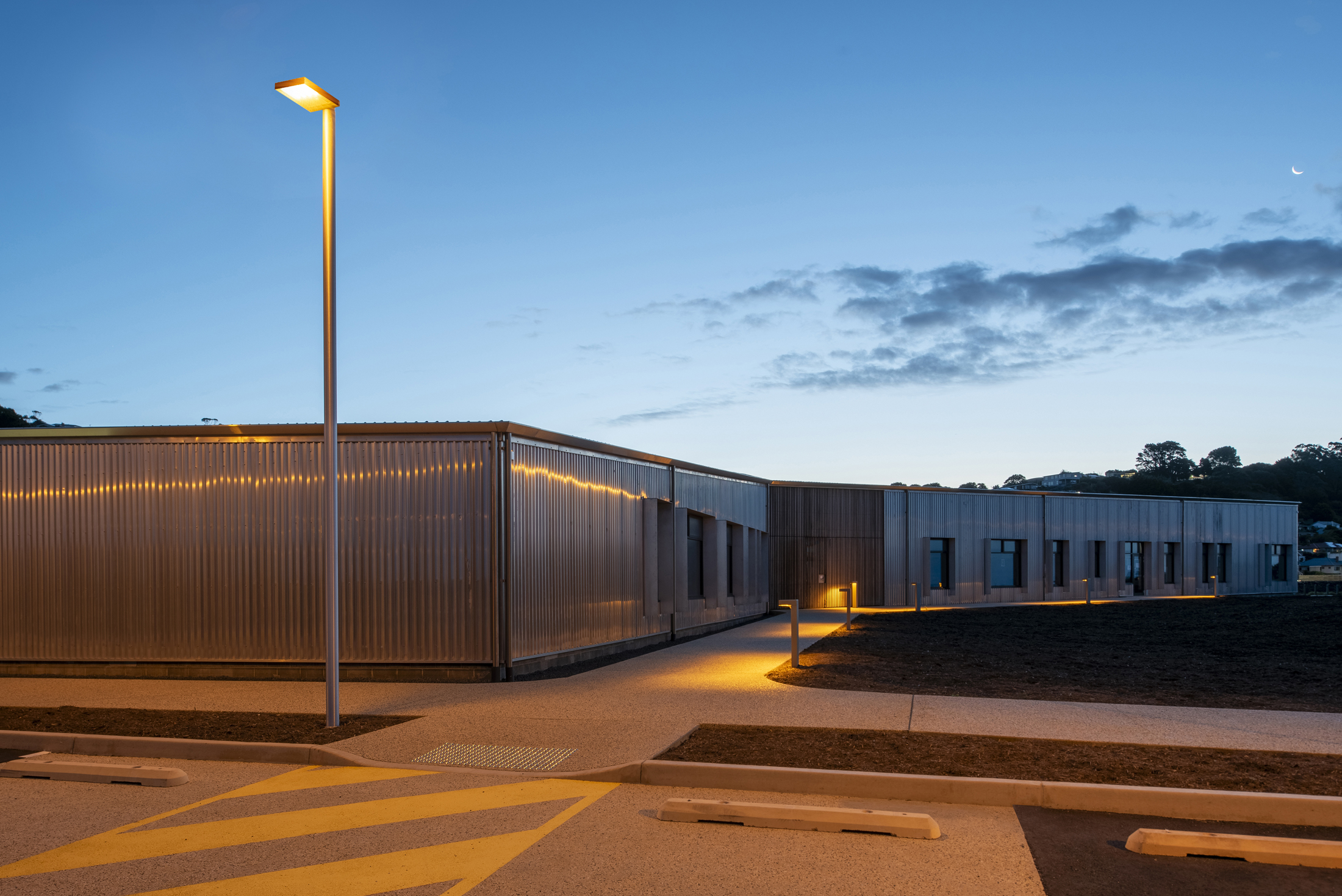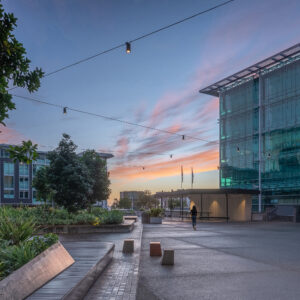
STREET & AREA LUMINAIRES, BOLLARDS, NIGHT SENSITIVE
Protecting penguins at UTAS Cradle Coast Campus, Tasmania
- Completed2023
- ClientUTAS
- Sales PartnerSouthern Lighting and Distribution
- ArchitectJohn Wardle Architects, supported by Philp Lighton
- Landscape ArchitectASPECT Studios
- Electrical EngineerEngineering Solutions Tasmania
- BuilderFairbrother
- Photography and VideographyIP Media
Situated near a penguin colony at the waterfront setting of West Park in Pataway/Burnie, the University of Tasmania’s (UTAS) Cradle Coast Campus is a unique ecologically sensitive zone that demands a special approach to lighting. Specifically, the project required a solution for the park and pathway that provided safety and functionality while minimising disruption to these beautiful creatures. ‘There was a focus on rehabilitating the landscape, increasing penguin visitation, and improving the connection between the Campus, the coast and Burnie itself’ explains Landscape Architects, ASPECT Studios.
Considerations
• Environmentally Sensitive Zone: The project site included a penguin colony, requiring special considerations to minimise the impacts of ALAN, particularly in considering mounting heights and colour temperatures, with a need to avoid blue light found in cooler colour temperatures, that could disorientate penguins and have them mistake the luminaires for the moon, impact their circadian rhythm and reproductivity amongst other challenges.
• Balancing Functionality and Aesthetics: Providing adequate lighting for car parks and pathways while maintaining a visually appealing campus environment.
• Durability: Ensuring robust solutions that could withstand the coastal environment and the test of time.
• Precision Optical Control: To ensure light is only directed where needed, without spill and with sharp cut-off and control.
• Control technology: The possibility to integrate motion detection to prevent lights being on unnecessarily when people are not in the vicinity, thus reducing energy consumption, the carbon footprint of the use phase of the luminaire and lessening the environmental impact simultaneously.
Challenges
With a focus on decreasing mounting heights near the penguin colony to minimise the visibility of light sources, the challenge of closer spacings (due to lower mounting heights) versus managing cost effectiveness to hit project budgets, required strategic consideration in spacing to mounting height ratios.
• Balancing amenity for humans with wildlife protection: Striking the balance between ensuring safety for humans to functionally use the path at night while minimising the impact this has on the environment was critical to the lighting strategy
• Light Spill Control: Mitigating light spill towards the penguin colony to minimise disturbance demanded by selecting luminaires with precise optics and sharp cut-off.
• Spacing vs. Mounting Height: Reducing light pole heights near the colony while maintaining lighting effectiveness in designated areas to balance the need for specialised lighting with high durability, longevity, and quality while maintaining cost-effectiveness.
Solution
Working collaboratively with Engineering Solutions Tasmania, and UTAS, Southern Lighting and Distribution provided a comprehensive solution with WE-EF luminaires that addressed all project considerations.
“Some compromises were made but overall, we saved money around the university by going higher in areas furthest from the waterfront to offset the use of bollards at the beach path” explains Landon Bannister of Southern Lighting. The ultimate solution incorporated WE-EF VFL530 street and area luminaires for the car park areas and pathways away from the colony and PSY424 bollards for the pathway in front of the colony.
The solution:
– WE-EF VFL500 Series luminaires: ADSA Approved (wildlife sensitive) and equipped with PC Amber Chip technology, these products offered efficient lighting for car park areas and pathways away from the penguin colony, reducing blue light spectrum and minimising impact on the penguins.
– WE-EF PSY400 Series bollards: Lined the pathways near the penguin colony, featuring superior spill light control to prevent light trespass towards the penguin habitat.
– Motion Sensor Integration: Strategically placed throughout the project, incorporated built-in motion sensors to further reduce light usage in areas with minimal activity.
PC Amber was selected as the colour temperature of choice for this project. It is widely understood that humans as well as most wildlife, particularly penguins, are sensitive to shorter wavelengths (blue), with it impacting their behaviour, psychology, survivorship and reproductive output.
Here, PC Amber provides safe wayfinding for people whilst containing <2% blue light content thereby being drastically less disruptive to the surrounding biodiversity than that of cooler colour temperatures. With PC Amber LED Chips equating to the colour temperature of approximately 1800 K, akin to a candle flame, a warm ambience is created with adequate visible light for humans to feel safe.
With all WE-EF products boasting a 5CE+ coastal-grade finish, key stakeholders were assured of the long-lasting performance that would be guaranteed in the harsh coastal environment.
“There was a focus on rehabilitating the landscape, increasing penguin visitation, and improving the connection between the Campus, the coast and Burnie itself.”
With this outdoor transformation of a much-loved community and educational precinct in the North-West, a new pedestrian network now connects the University Campus to the coast, with gentle and thoughtfully considered illumination, while at the same time, protected penguin habitats have been created and foreshore vegetation expanded. We are thrilled to see this project come to fruition, which was a fascinating combination of conservation and landscape reinvigoration’, explains Landscape Architects, ASPECT Studios.
The project achieved its primary goal of providing safe and functional lighting while minimising disturbance to the penguin colony. This was a clever multi-faceted approach:
– Some compromises were made to save money and ensure overall value, such as maximising mounting heights of luminaires where feasible to minimise the number of luminaires needed which was able to offset the cost of the additional luminaires needed where the mounting height is lower (using bollards) in the vicinity of the penguin colony along the beach path
– PC Amber colour temperature was selected to minimise the impact blue light has on the local wildlife
– Strategically placed motion sensors were integrated to significantly minimise the in-use phase of the carbon footprint of the luminaires
– The chosen WE-EF luminaire mix balances functionality with a visually appealing design, complementing the university campus
The result is a shining example of clever, considered lighting that is both environmentally considered and energy efficient. Congratulations to everyone involved in the delivery of this project, WE-EF LIGHTING is proud to have been involved in the exemplary case that demonstrates how lighting solutions can be effectively implemented in ecologically sensitive projects, providing a balance between functionality, aesthetics, and environmental responsibility.







